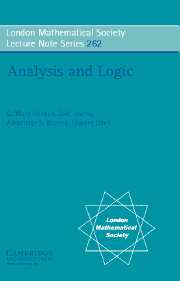Book contents
- Frontmatter
- Contents
- Preface
- Introduction
- Part One: Ultraproducts in Analysis
- 1 Introduction
- 2 Normed Space Structures
- 3 Signatures
- 4 Ultrapowers of Normed Space Structures
- 5 Positive Bounded Formulas
- Basic Model Theory I
- 7 Quantifier-Free Formulas
- 8 Ultraproducts of Normed Space Structures
- 9 Basic Model Theory II
- 10 Isomorphic Ultrapowers
- 11 Alternative Formulations of the Theory
- 12 Homogeneous Structures
- 13 More Model Theory
- 14 Types
- References
- Index of Notation
- Index
- Actions of Polish Groups and Classification Problems
- On Subspaces, Asymptotic Structure, and Distortion of Banach Spaces; Connections with Logic
10 - Isomorphic Ultrapowers
Published online by Cambridge University Press: 05 May 2013
- Frontmatter
- Contents
- Preface
- Introduction
- Part One: Ultraproducts in Analysis
- 1 Introduction
- 2 Normed Space Structures
- 3 Signatures
- 4 Ultrapowers of Normed Space Structures
- 5 Positive Bounded Formulas
- Basic Model Theory I
- 7 Quantifier-Free Formulas
- 8 Ultraproducts of Normed Space Structures
- 9 Basic Model Theory II
- 10 Isomorphic Ultrapowers
- 11 Alternative Formulations of the Theory
- 12 Homogeneous Structures
- 13 More Model Theory
- 14 Types
- References
- Index of Notation
- Index
- Actions of Polish Groups and Classification Problems
- On Subspaces, Asymptotic Structure, and Distortion of Banach Spaces; Connections with Logic
Summary
In this chapter we prove isomorphism theorems for ultrapowers and ultraproducts of normed space structures. These results show that there is a very tight connection between (a) properties that are preserved under the ultraproduct construction and (b) properties that are expressible using the logic for normed space structures that is described in this paper.
Let L be a signature and let ℳ and N be two normed space L-structures. If ℳ and N have isomorphic ultrapowers, by Corollary 9.4 they must be approximately elementarily equivalent. Theorem 10.7 below gives the converse (in a strong form). Together these results show that ultrapower equivalence of ℳ and N is the same as approximate elementary equivalence. (See the discussion of this issue in the Introduction.)
Theorem 10.8 below is a similar result for ultraproducts. Among other things, it shows that the ultrafilter guaranteed by Theorem 10.7 can be chosen in a highly uniform way and that the ultrapowers in question can be taken to be highly saturated. The uniformity will be exploited in Chapter 12 to prove the existence of ultrapowers that are highly homogeneous (in addition to being highly saturated).
The results in this chapter are analogous to the Keisler-Shelah Theorem in ordinary model theory. (See [She71] and Chapter 6 in [CK90].) Moreover, our proof follows a similar line of argument, with adjustments appropriate to the handling of positive bounded formulas and their approximations.
- Type
- Chapter
- Information
- Analysis and Logic , pp. 55 - 71Publisher: Cambridge University PressPrint publication year: 2003



